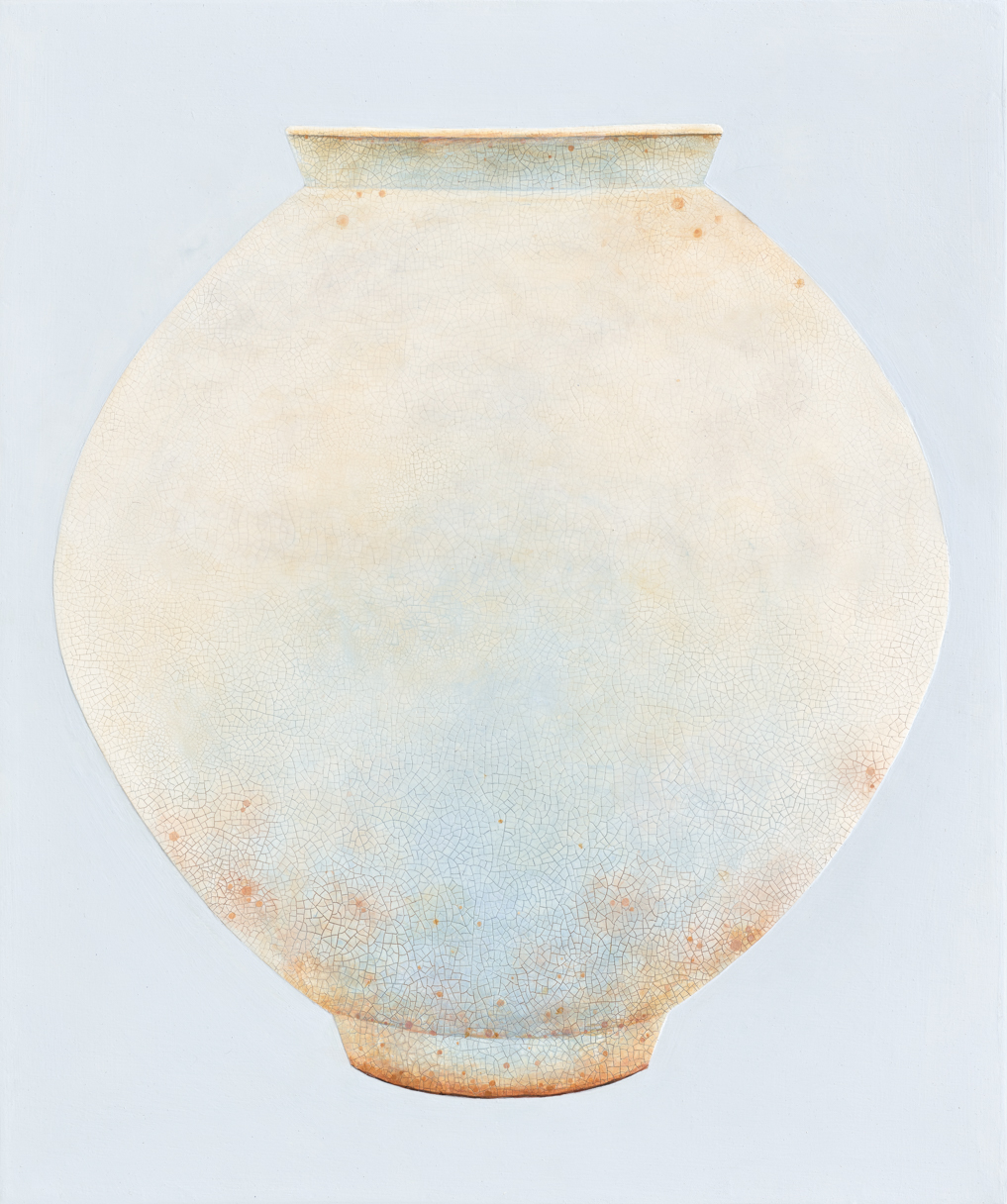홀리(HOLY)
2024. 2. 29 - 4. 20 | [GALLERIES] ARARIO GALLERY SEOUL
노상호

아라리오갤러리 서울 1F 전시전경
아라리오갤러리 서울은 2024년 2월 29일(목)부터 4월 20일(토)까지 노상호(b. 1986) 개인전 《홀리》를 연다. 온라인에서 발견한 저화질 이미지를 재료 삼아 독창적인 회화 세계를 구축해 온 노상호의 근작을 집중 조명하는 전시다. 〈홀리〉(2022~) 연작은 동시대 미디어 환경 변화에 민감하게 대응하는 작가가 AI 이미지 생성 프로그램을 작업에 도입한 결과물이다. 노상호는 AI가 만든 이미지가 현실의 통념과 어긋나는 지점에서 감각되는 경이 또는 두려움의 정서를 신화적 ‘성스러움’에 비유한다. 기술적 오류로 인해 생성된 비현실적 장면들을 ‘기적’으로 일컬으며 디지털 및 아날로그 세상을 오가는 스스로의 영매적 정체성을 상상하는 것이다. 출품작은 2023년과 2024년에 걸쳐 만든 작품들로 구성됐다. 아라리오갤러리 서울의 1층, 3층, 4층에서 회화와 조각, 영상 등 다양한 형식으로 확장된 〈홀리〉 연작을 다채롭게 만나볼 수 있다. 홍이지 국립현대미술관 큐레이터가 이번 전시의 서문을 쓴다. 개막에 맞물려 작가가 지난해 제작한 365점 드로잉과 12점 회화를 수록한 연간 화집 『더 그레이트 챕북 2023』(2024) 및 〈홀리〉의 대표적 도상인 불타는 눈사람을 본뜬 양초 ‘홀리 캔들 스노우맨’, 근작 이미지를 품은 ‘홀리 태피스트리’ 3종이 전시연계 상품으로서 출시된다.

노상호, 〈홀리〉(2024), 캔버스에 아크릴릭, 116.8 x 91 cm
노상호의 〈홀리〉 – AI 이미지 시대, 경이와 공포의 양가적 감정
동시대 미디어 환경을 핵심적인 참조 요소로 삼아 작업하는 노상호는 낯선 기술의 영향에 동시적으로 반응하고자 노력한다. 2021년부터 3D 영상 제작기술을 익혀 작업의 한 갈래로 도입하고, 2022년 AI 이미지 생성 프로그램을 사용하여 얻은 결과물들을 회화의 소재로 활용하기 시작하는 등 작업 방식의 변주는 늘 새로운 미디어 기술의 등장에 밀접하게 결부하여 일어난다. 직접 온라인을 서핑하며 이미지를 수집하던 기존의 방식에서 나아가, AI가 생성한 수많은 이미지를 가운데 직관적으로 선택한 도상들을 화면으로 끌어오게 되면서 〈홀리〉 연작이 탄생했다.

노상호, 〈홀리〉(2024), 캔버스에 아크릴릭, 116.8 x 91 cm
〈홀리〉는 오늘날 디지털 이미지의 또 다른 창작 주체로서 새롭게 등장한 AI의 존재를 작업 과정에 적극 받아들인 결과물이다. AI가 만든 이미지를 재료 삼아 재구성한 화면은 실재하는 세계를 닮은 한편 보다 극적인 장면으로서 완성된다. 현재 상용화된 AI 이미지 생성 프로그램은 결과물이 ‘사실적으로’ 보이게끔 도출하도록 학습되어 사진처럼 견고한 장면을 구성하는 경우가 많다. 그러나 동시에 기술의 불완전함 탓에, 머리가 두 개인 사슴이나 손가락이 여섯 개인 사람, 거대하게 불타는 눈사람처럼 현실 세계의 논리와 조금씩 어긋난 기이한 도상을 만들어 내기도 한다. 결코 사실적이지 않은 것을 사실적으로 묘사한 이미지를 마주하게 되는 것이다. 노상호는 AI가 만든 특정 장면들이 선사하는 경이와 공포의 양가적 감정을 신화 및 종교적 성스러움에 빗대어 본다.
디지털과 아날로그의 중간지대 – 한 쪽 눈으로는 가상을, 다른 눈으로는 현실을 보기

노상호, 〈홀리〉(2024), 캔버스에 아크릴릭, 300 x 300 cm
〈홀리〉의 소재는 AI가 만들어 낸 이미지들이다. 노상호는 주로 문자 대신 자신의 기존 작품 이미지를 AI 이미지 생성 프로그램에 입력한 후 재해석을 유도한다. 출력된 결과물 가운데 도상을 선택하여 새로운 회화의 화면으로 옮겨오는 방식이다. 화면에 자주 보이는 ‘불타는 눈사람’도 그렇게 얻은 도상 중 하나다. 커다랗게 불타는 눈사람의 형상이 자신의 주제를 함축한 상징과 같다고 여겨 화면에 거듭 묘사하게 됐다. 현실세계에서 절대로 실현될 수 없는 신비하고도 기이한 광경들은 디지털 스크린을 건너 회화의 화면 위에 다시금 재현된다.

노상호, 〈홀리〉(2024), 3D 프린트, 35 x 25 x 25cm, Ed. 1/10
노상호는 스스로의 작업이 “디지털 스크린이 늘 곁에 붙어 있는 아날로그 회화”라고 이야기한다. 디지털 요소를 적극적으로 활용하면서도 궁극적으로 손으로 직접 그리는 행위로의 귀결이 중요하다는 의미다. 작가는 〈홀리〉의 제작을 위하여 에어브러시를 작업 과정에 처음 도입했다. 물감을 분사하여 그리는 도구로, AI가 생성한 이미지의 매끈한 견고함을 재현하기에 적합한 한편 붓에 비하여 직관과 우연성이 개입할 여지를 열어 주는 매체라는 판단에서다. 유채, 수채, 아크릴릭 물감을 혼용하며 화면의 질감을 다양화한 시도가 돋보인다. 일부에서는 석고를 활용해 부피감을 극대화하거나 거친 질감을 표현한 사례도 눈에 띈다. 재료의 촉각적 속성을 돋보이도록 함으로써 스크린을 통하여 보는 이미지와 실재하는 회화의 화면 사이 상이한 감각을 증폭시키는 장치다.

노상호, 〈홀리〉(2024), 빈티지 옷장에 아크릴릭, 목재에 수성페인트, 패브릭, 양초, 약 225.5 (h) x 224 x 275 cm, 가변크기 (협력 김동희)
〈홀리〉 연작은 회화를 중심 삼아 3D 프린터로 출력한 조각, 3D 영상 제작 프로그램으로 만든 영상, 설치 작품 등 다양한 형식으로 재해석된다. 아라리오갤러리 서울 4층 전시 공간에 선보인 설치 작품은 작가가 수집한 빈티지 옷장을 화폭 삼아 그림을 그린 후 목재 구조물 및 패브릭, 양초 등 다양한 요소를 결합하여 완성한 것이다. 전시 공간 내 기둥에 해당 옷장이 비스듬히 끼여 있는 모습으로 연출된다. 게임 속 글리칭Glitch, Glitching) 현상, 즉 기술 오류로 인해 장면 속 요소가 기이하게 뒤엉킨 상황을 재연한 결과물이다. 한편으로는 전체의 작품이 일종의 제단과 같은 모양새로 보이기를 의도했다. 작품은 디지털 가상세계에서 일어나는 비현실적 사건의 한 사례를 실제 장소 안에 제시하여 보여준다.
아라리오갤러리 서울
서울시 종로구 율곡로 85
02 541 5701
[GALLERIES] ARARIO GALLERY SEOUL
- Dates
- 2024. 2. 29 - 4. 20











